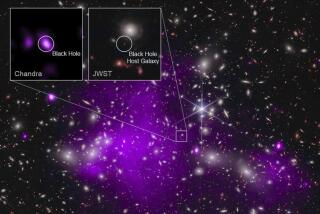Scientists reach a surprising conclusion about black holes
- Share via
Astronomers think they have finally solved the cosmic chicken-and-egg problem of what came first -- the giant black holes lying at the center of many big galaxies or the galaxies that feed them?
The answer: the black holes.
The finding, which surprised even the scientists involved, implies that black holes grow the galaxies surrounding them, like a garden springing from a single seed or a man growing a suit of clothes.
The problem with that idea, according to the scientific team that presented the findings Wednesday at the American Astronomical Society meeting in Long Beach, is that nobody has come up with an explanation for how a black hole could sprout a galaxy.
“That is hard to imagine,” said Chris Carilli of the National Radio Astronomy Observatory.
A black hole is the remains of a giant star that has collapsed -- typically after exploding in a supernova -- to what is known as a singularity, in which the gravity is so extreme that nothing, not even light, can escape. The researchers based their work on past studies showing that for any given galaxy there is a constant ratio between the masses of a central black hole and the “bulge” of stars and gas relatively close to the galaxy’s center.
In the nearby universe, that ratio is the same for black holes ranging from a few million times the mass of the sun to behemoths billions of times its mass, as is the case with the gigantic black hole at the heart of our own Milky Way galaxy.
“The big question,” according to Caltech astronomer Dominik Riechers, “has been whether one grows before the other or if they grow together.”
To find out, Carilli, Riechers and others on their team used telescopes that capture radio waves instead of visible light to study the first galaxies in the universe. Those date to the time when the universe, which is now 13.7 billion years old, was less than 1 billion years old.
They found these ancient galaxies by studying the degree to which their light was shifted toward the red end of the spectrum. The greater the redshift, which is a measure of how fast the galaxy is speeding away from us, the older the galaxy.
Next, they weighed the black hole and the galaxy’s bulge, a challenging calculation that is done by observing the movements of the galaxy’s clouds of gas, which are influenced by gravity. In four early galaxies -- which are so distant that they appear to us in their youth -- the ratio between the black hole and the galaxy bulge was different from what was expected, the scientists said.
“The black holes in these young galaxies are much more massive compared to the bulges than those seen in the nearby universe,” according to Fabian Walter of the Max Planck Institute for Radio Astronomy in Germany and another member of the team.
That, according to the scientists, means the black holes started growing first.
Carilli and Riechers said much more work needs to be done to confirm the discovery. For one thing, more early galaxies must be found and studied. This will take time, since the calculations done on just the four studied so far required hundreds of hours of viewing time on various radio-wave dishes, including the Very Large Array in New Mexico.
Researchers also need to better understand the relationship between a black hole and its galaxy bulge.
Two radio telescopes under construction, the Expanded Very Large Array -- an upgrade to the New Mexico site -- and the Atacama Large Millimeter/Submillimeter Array in Chile, will make it easier to make detailed images.
There are other possible explanations for the difference in the ratio besides the idea that the black hole chicken came before the galaxy egg, Riechers said. One guess is that fundamental laws of nature, such as the force of gravity, may have been different long ago, although that is considered a longshot.
--






